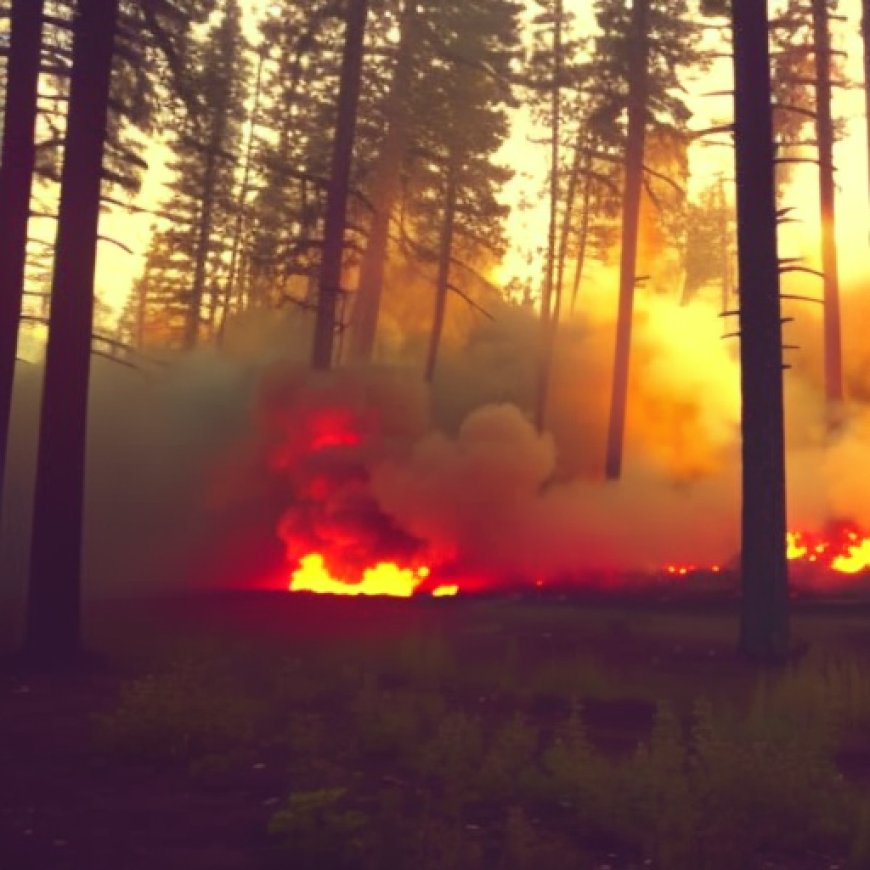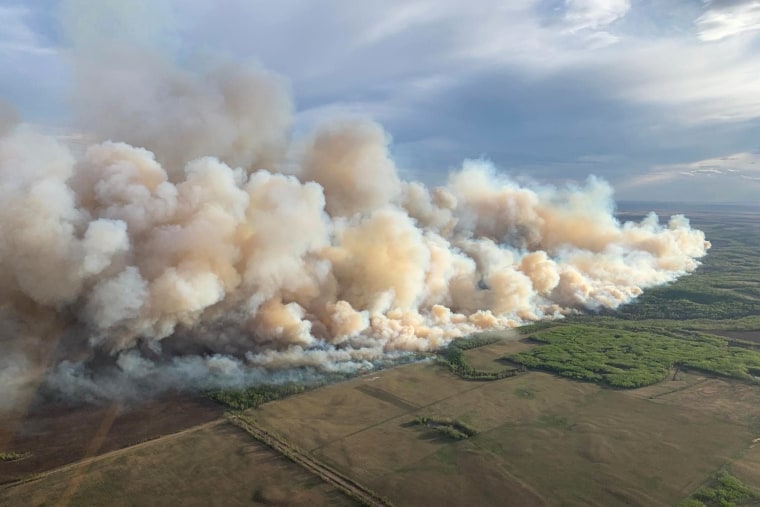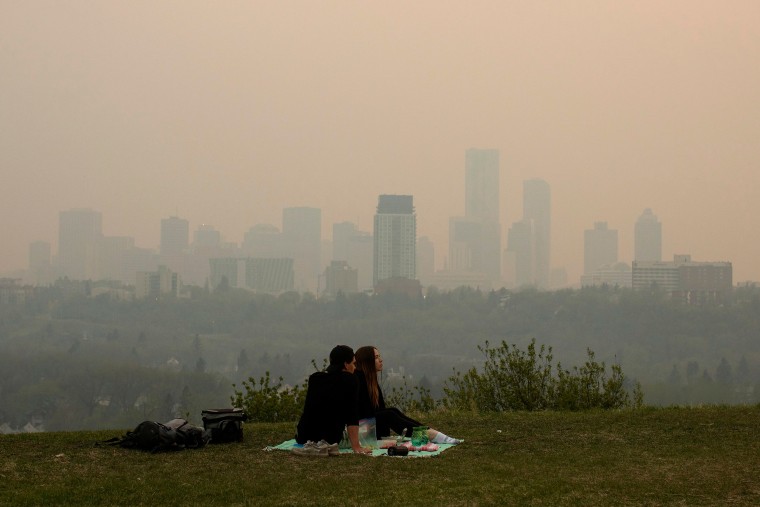Canadian wildfires trigger air quality alerts across 4 U.S. states
Canadian wildfires trigger air quality alerts in four U.S. states NBC News


Hazy Conditions Due to Wildfires in Western Canada
Hazy conditions blanketed parts of four U.S. states Monday, as smoke from wildfires in western Canada triggered air quality alerts and warnings.
Wildfires in Western Canada
- Canada has 146 active wildfires burning, including dozens in British Columbia and Alberta that are characterized as “out of control,” according to the Canadian Interagency Forest Fire Centre.
Air Quality Alerts in the United States
- Alerts were in effect in Montana, North Dakota, South Dakota, and Minnesota, as winds carried plumes of smoke over the region.
- The Minnesota Pollution Control Agency issued an air quality alert Sunday in response to a “band of very heavy smoke from wildfires in northeast British Columbia.”

Air Quality Index
The air quality index Monday showed conditions across the four states ranging from “moderate” to “unhealthy” for the general public. The index was established by the U.S. Environmental Protection Agency to measure daily air pollution levels and communicate the associated risks.
Impact of Wildfire Smoke on Health
- Air pollution from wildfires is closely tracked because small particles in smoke that are less than 2.5 micrometers in diameter — about 4% of the diameter of an average human hair — are small enough to reach deep inside the lungs.
- Exposure to this type of particulate pollution can cause inflammation and weaken the immune system, and may also exacerbate or increase the risk of asthma, lung cancer, and other chronic lung diseases. Older people, infants, children, and pregnant individuals are most vulnerable when air quality worsens.
Air Quality Index Components
The air quality index measures that small particle pollution, called PM2.5, along with four other major pollutants: ground-level ozone, carbon monoxide, sulfur dioxide, and nitrogen dioxide.

Current Wildfire Situation in Canada
- Fires have engulfed more than 24,000 acres in western Canada, marking the first series of major wildfires this season.
- On Sunday, authorities issued an evacuation order for thousands of residents in Northern Rockies Regional Municipality and Fort Nelson First Nations in British Columbia because of fast-moving blazes.
Previous Wildfire Impacts
- Last summer, smoke from wildfires in Quebec blanketed huge portions of the U.S., sending air quality levels plummeting in cities from the Midwest to the Eastern Seaboard.
- Canada experienced its most devastating wildfire season in recorded history last year, with more than 45 million acres burned, according to the Canadian Interagency Forest Fire Centre.
Increased Fire Risk and Climate Change
The Canadian government said Friday that drought conditions “are expected to persist in high-risk regions in May,” increasing the “risk and intensity of both natural and human-caused wildfires.”
Studies have shown that climate change is creating warmer conditions that can more easily dry out vegetation, a key ingredient for wildfires to ignite and spread. As such, wildfires are expected to be more frequent and more intense in a warming world.
SDGs, Targets, and Indicators
1. Which SDGs are addressed or connected to the issues highlighted in the article?
- SDG 3: Good Health and Well-being
- SDG 11: Sustainable Cities and Communities
- SDG 13: Climate Action
- SDG 15: Life on Land
2. What specific targets under those SDGs can be identified based on the article’s content?
- SDG 3.9: By 2030, substantially reduce the number of deaths and illnesses from hazardous chemicals and air, water, and soil pollution and contamination.
- SDG 11.6: By 2030, reduce the adverse per capita environmental impact of cities, including by paying special attention to air quality and municipal and other waste management.
- SDG 13.1: Strengthen resilience and adaptive capacity to climate-related hazards and natural disasters in all countries.
- SDG 15.1: By 2020, ensure the conservation, restoration, and sustainable use of terrestrial and inland freshwater ecosystems and their services.
3. Are there any indicators mentioned or implied in the article that can be used to measure progress towards the identified targets?
- Air quality index (AQI): Measures the level of air pollution, including small particle pollution (PM2.5), ground-level ozone, carbon monoxide, sulfur dioxide, and nitrogen dioxide.
- Number of active wildfires: Indicates the severity of the wildfire situation.
- Area burned by wildfires: Reflects the extent of the wildfires and their impact on ecosystems.
Table: SDGs, Targets, and Indicators
| SDGs | Targets | Indicators |
|---|---|---|
| SDG 3: Good Health and Well-being | SDG 3.9: By 2030, substantially reduce the number of deaths and illnesses from hazardous chemicals and air, water, and soil pollution and contamination. | Air quality index (AQI) |
| SDG 11: Sustainable Cities and Communities | SDG 11.6: By 2030, reduce the adverse per capita environmental impact of cities, including by paying special attention to air quality and municipal and other waste management. | Air quality index (AQI) |
| SDG 13: Climate Action | SDG 13.1: Strengthen resilience and adaptive capacity to climate-related hazards and natural disasters in all countries. | Number of active wildfires |
| SDG 15: Life on Land | SDG 15.1: By 2020, ensure the conservation, restoration, and sustainable use of terrestrial and inland freshwater ecosystems and their services. | Area burned by wildfires |
Note: The article does not explicitly mention the specific targets and indicators. The identified targets and indicators are inferred based on the issues discussed in the article.
Copyright: Dive into this article, curated with care by SDG Investors Inc. Our advanced AI technology searches through vast amounts of data to spotlight how we are all moving forward with the Sustainable Development Goals. While we own the rights to this content, we invite you to share it to help spread knowledge and spark action on the SDGs.
Fuente: nbcnews.com

Join us, as fellow seekers of change, on a transformative journey at https://sdgtalks.ai/welcome, where you can become a member and actively contribute to shaping a brighter future.







